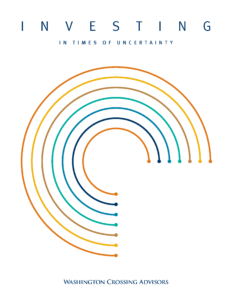Insight & Commentaries
When most of us think about growth, the focus is usually on how quickly a company might expand in the future and, sometimes, on recent growth. But the more important question for your portfolio may actually be not how much growth a company might deliver — it is how confident we can be in that growth. We will argue here that during risk-loving bull markets (like today), focus tends to shift to the “how much” question, and during more normal, risk-aware markets, reverts to the “how confident” question. To prove our point, we will offer three charts. The first chart…
Dividend investing allows investors to focus on fundamentals rather than becoming distracted by the stock market’s constantly changing mood. This premise has been repeated decade after decade by some of the greatest market scholars who ever lived. This perspective lies at the heart of what we do at Washington Crossing Advisors (WCA). The WCA Rising Dividend portfolio strategy centers on dividend increases from solid, high-quality companies at reasonable prices. Consistent dividend payments from fundamentally strong companies (low debt, profitable assets, consistent business) allow us to look through short-term market noise and stay focused on the long-term prospects of a business….
As 2025 draws to a close, the economy remains stronger than many expected. The Federal Reserve’s modest 0.25% rate cut to 4.25% signals a gentler stance, but persistent inflation suggests only gradual easing ahead. Equity and credit markets have rallied to record valuations, leaving limited margin for disappointment. Bonds once again offer meaningful real returns and portfolio balance, while global growth leadership is shifting toward developed markets. With optimism high and valuations stretched, we believe investors should emphasize diversification, quality, and flexibility—positioning portfolios to potentially benefit from resilience while staying prepared for bouts of volatility that often follow periods of…
Our recent lag versus the S&P 500 reflects a market led by lower-quality and extremely highly valued companies. While challenging, this is a well-understood dynamic of quality investing. Low-quality phases can last for a time, but history has shown they were followed by renewed leadership in high quality. The current low-quality phase is already longer than average and may be nearing exhaustion. Credit and valuation signals now suggest downside risks are rising even as the economy continues to expand. Where We Are Now This has been a speculative stretch: lower rate hopes, and pro-growth policy expectations have pulled the leadership…
The Federal Reserve meets this week to determine the next steps for monetary policy. And while the Federal Open Market Committee appears divided as to the appropriate future course for policy, financial markets are positioned for significant rate cuts ahead. As the chart below shows, the futures market is betting on 5-6 rate cuts by the end of next year, ultimately lowering short-term policy rates to under 3% from today’s rate near 4.5%. The committee meets under intense pressure to act as inflation remains well above target and amid signs of slippage in job growth. Markets Priced for Big Cuts…
Markets have proven more resilient than expected in the first half of 2025, rebounding quickly from tariff-driven volatility. While headline earnings remain strong, pressures are building beneath the surface — particularly in inflation, valuations, and global growth dynamics. Foreign developed markets have outpaced the U.S., supported by a weaker dollar and improving international conditions. Meanwhile, we are raising our long-run U.S. productivity forecast to 2.5% from 1.75%, reflecting growing confidence in the transformative impact of AI. Like the internet boom of 1995–2005, we expect AI to drive meaningful productivity gains, boosting long-term equity return potential.
Stock prices are more than numbers on a screen. They tell us what market participants believe. These beliefs are distilled into prices that reveal investors’ changing expectations about the future. The expectations are not those of a CEO or a handful of analysts — they are the aggregate judgment of all the actual buyers and sellers of stocks who set prices each day. By applying a basic valuation framework[1] to the five hundred largest U.S. companies, we can tease out what the market assumes about long-run growth in perpetuity. This is not about next quarter or even the next decade….
Let’s begin with some simple math. If you invest $100,000 and lose 10% in the first year, you’re down to $90,000. If you then gain 10% in year two, you don’t break even. You end up with $99,000. That’s a net loss of $1,000—despite an average return of zero percent. How is this possible? It’s because averages lie. What matters in the real world is not average return but compound return. The number that shows up on your statement at the end. Now consider a more extreme case. You lose 50% in year one, then gain 50% in year two….



